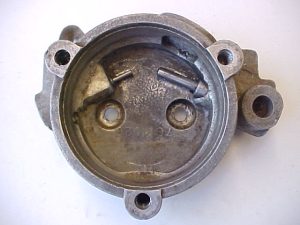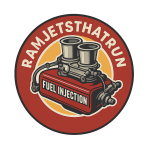Let’s face it… GM never did get the cold enrichment system design quite right for the ’57 – ’65 Corvette fuel injection units. They did come close with the ’63 – ’65 hot air choke design, but even that one needs help to work properly.
The design of the ’57 – ’61 cold enrichment mechanism was an evolving bad joke. It worked as well as a broken clock; it would be right occasionally, but not very often. Its biggest problem was the on-or-off way it richened the A/F mixture.
The cold enrichment came on and went away in one distinct, rather than many gradual, steps. Initially no vacuum would be sent to the fuel meter enrichment diaphragm. This kept the lever parked on the power stop during the first minute of operation. The result was a super-rich mixture until the enrichment lever was allowed to swing over to the economy stop.
This system used an electric heat coil to control activation. This coil usually cooled off much faster than the engine block. When an owner would re-start his car after letting it sit only 20 – 30 minutes, the cold enrichment system would be activated although the warm engine didn’t really need an over-rich mixture.
The first true “choke” type FI cold enrichment system was introduced in 1962. It featured a butterfly plate in the air meter controlled by an electrically heated coil. While it did come on and go away in a gradual motion, it was problematic too. The coil still cooled off faster than the engine. A new problem was introduced as well. The steel butterfly plate was installed on a relatively flexible aluminum shaft. That shaft passed through four (count-’em) four holes in the pot metal venturi cone. Over many heating / cooling cycles the pot metal cone would warp. This would throw the four shaft holes out of alignment, causing the butterfly shaft to bind.
Chevrolet finally went to an exhaust heat controlled choke in 1963. This made the choke activation more a function of true engine heat. The steel choke butterfly was still installed on an aluminum shaft. In this design it passed though “only” three holes in the pot metal venturi cone. However, the shaft would still bind due to changing dimensions after many heating cycles. A new problem was the over-rich mixture caused by the butterfly being too restrictive to air flow when the choke was fully engaged.
I believe GM tried to correct the ’63 – ’65 choke over-rich problem by selling an “FI Choke Modification Kit” at their parts counters. The kit included a choke pull-off piston to be installed in the choke housing, a more aggressive fast idle cam, and a weaker bimetallic spring on a new choke cover. This kit is best remembered for introducing a new problem. Engine manifold vacuum would move the pull-off piston down when the engine was running. This piston motion would hold the choke butterfly open against the closing force of the bimetallic spring until the spring warmed up. However, carbon / dirt would build up in the piston bore and eventually cause the piston to stick.
There’s really not much you can do to improve the operation of the ’57 – ’61 FI cold enrichment systems. I’ll admit they will work adequately to get you down the road when the engine is cold. You’ll just have to tolerate the over-rich mixture they produce initially.
You can make several simple improvements to the ’62 – ’65 choke systems. First, you can align-bore the choke shaft holes in the venturi cone slightly over-size. This will allow the aluminum butterfly shaft to rotate freely again. I would also recommend buying a reproduction butterfly plate and cutting a large window in it. This will effectively lean out the mixture when the butterfly is closed without having to endure the hassles caused by installing a sticking pull-off piston in the choke housing.

